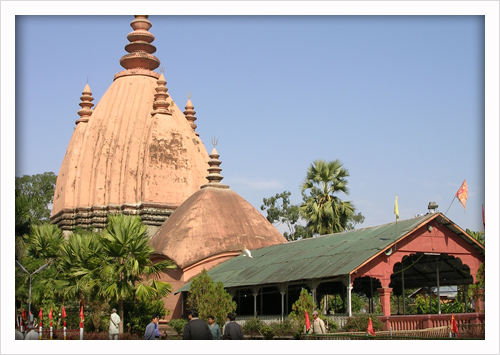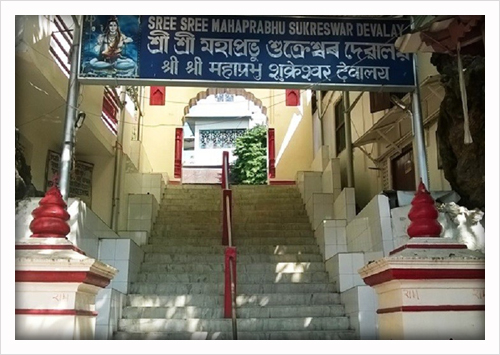Temples
The State of Assam has numerous temples and monuments, which stands witness to the great historical and cultural past dating back to the medieval days. Many ancient Hindu temples of Assam have some root in mythological legends. Assam is the land of Vaishnava Gurus like Sankardeva and Madhavdeva and you will find various temples devoted to various Gods. Some of the popular Temples in Assam are:
Kamakhya Temple

The Kamakhya Temple, situated on the Nilachal Hill in western part of Guwahati city in Assam is one of the oldest of the 51 Shakti Peethas in India. The main temple is surrounded by individual temples dedicated to the ten Mahavidyas: Kali, Tara, Sodashi, Bhuvaneshwari, Bhairavi, Chhinnamasta, Dhumavati, Bagalamukhi, Matangi and Kamalatmika.
Being the centre for Tantra worship this temple attracts thousands of tantra devotees in an annual festival known as the Ambubachi Mela. Another annual celebration is the Manasha Puja. Durga Puja is also celebrated annually at Kamakhya during Navaratri in the autumn. This five-day festival attracts several thousand visitors.
Negheriting Shiva Doul

The Negheriting Shiva Doul is situated on a hillock at about one and half km north from the National Highway 37 in the Golaghat district of Assam.
The temple was first constructed by the Kacharis during 8th – 9th century AD. However, it was destroyed many times in natural calamities and the present form of the temple was built by the Ahom king Rajeswar Singha. The beautifully decorated Shiva Doul is bordered by four small Douls in the four corners. The Shiva Doul comprises the 'Bana linga' that is some 3ft in diameter, whereas, the smaller douls are devoted to Ganesh, Vishnu, Durga and Surya.
Siva Dol
The Siva Dol, located on the banks of the Borpukhuri, in the heart of Sivasagar is a group of structures comprising three Hindu temples of Siva Dol, Vishnu Dol and Devi Dol shrines, and a museum. The Siva Dol is devoted to Lord Shiva, the Vishnu Dol is devoted to Lord Vishnu and the Devi Dol is devoted to the Goddess Durga.
The height of the Siva Dol is 104 feet and the base of the temple measures 195 feet in circumference. It is crowned with an 8-foot high golden-dome.
Every year, during the Mahashivaratri, a huge fair is organized in the Shiva temple and pilgrims visit from all parts of India to offer puja. During the Hindu month of Sawan (August- September), Hare Krishna kirtan, chanting of the Hare Krishna mantra, is conducted all through the night, which is also a major attraction for the devotees.
The Dol Yatra and Rath Yatra are two annual festivals celebrated at Vishnu Dol. Durga Puja is celebrated every year with great fervour during September–October at Devidol.
Kedareswara Temple

Kedareswar temple is a significant medieval temple dedicated to Lord Shiva, constructed by the Ahom King Rajeswar Singha in the year 1753. The temple is located on the top of Madanchala Hillock in Hajo about 32Km from Guwahati, Assam. This is one of the rare Svyambhu (self-originated) linga in the Ardhnareswar (male & female) form of Lord Shiva. The ‘linga’ is kept covered by a metal bowl by the priests.
Asvakranta Temple

The Asvakranta Temple is one of the most important shrines of Lord Vishnu. The deity worshiped here is called Anantasayin Vishnu which refers to the sitting position of the lord Vishnu on the serpent.
The Temple is located on the North of Guwahati, Assam on a rocky bed near the Brahmaputra river. It is believed that a visit to this shrine washes away all the sins of a person and help him to attain moksha (salvation).
According to the legend, Lord Sri Krishna stopped here with his army and the horses before he killed Narakasur who was the ruler of this land. The term “Asvakranta” means “ascended by horse”' and hence the temple got its name. The temple is known for its magnificent scenic beauty and panasonic charm.
Basistha Temple

The Basistha temple, located in the south-east corner of Guwahati city is a Shiva mandir constructed by Ahom King Rajeswar Singha in 1764.The history of the Basistha Ashram where the temple is located dates back to the Vedic age.
This temple is believed to be the home of famous sage Basistha, also known as "Vasishtha". The temple is located on the outskirts of Garbhanga reserve forest in Guwahati which has an ample population of elephants. Although people worship the temple but still the cave in which the sage Basistha is believed to have meditated is located 5 km inside the temple.
The temple stands on the bank of the mountain streams originating from the hills of Meghalaya, which becomes the rivers Basistha and Bahini/Bharalu flowing through the city.
Dhekiakhowa Bornamghar

Dhekiakhowa Bornaamghar is located in Jorhat district, Assam, India that was established by saint-reformer Madhavdeva . He kindled an earthen lamp there, which has been continuously burning since then being religiously refuelled with mustard oil by the priests till date. It is located at Dhekiakhowa village of Jorhat district, 15 km towards the east of Jorhat city 3.5 km away from National Highway 37. It is called a Bornaamghar because of its historical association and large campus.
There is an anecdote after the name of Dhekiakhowa Naamghar. Guru Madhavdeva after taking up the duty of reforming people and spreading the Ekasarana Nam Dharma came to stay in this small and very poor village. He took shelter for the night at the hut of an old woman, who served him rice with Dhekia Saak (a very common wild vegetable, but very popular and with an excellent taste). The old woman was very embarrassed to have served the Saint guru like this but he was immensely pleased by the dinner. So, he started a namghar there and given the responsibility of kindling the earthen lamp to the old woman. That is why the naamghar was later known as Dhekiakhowa Naamghar. The place is inevitably named after the Naamghar itself.
A lot of visitors and devotees gather in the naamghar every day, especially during the sacred month of Bhado (August–September), for this month being the Death Anniversaries of both the gurus Srimanta Sankardeva and Madhavdeva.
Bhairabi Temple
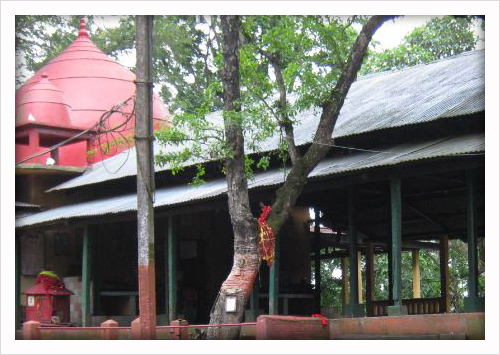
The Bhairabi Temple is located in Kolibari in the outskirts Tezpur in Assam. The temple is a sidhapitha where people offering prayer and fulfill their wants with the blessings of MaaBhairabi. Legend has it that Usha (daughter of mighty Asura King Banasura) regularly came here for the worshiping of the Goddess. The Durga Puja celebration is performed in a very grand way in this temple. There are sacrificial offerings of goats, ducks, pigeons, etc. that still occurs regularly in this temple.
Umananda Temple

This Shiva Temple is located in “Umananda” the smallest river island in the midst of river Brahmaputra flowing through the city of Guwahati in Assam. The British named the island Peacock Island for its structure.
According to Hindu mythology, Shiva created the island for his wife Parvati's happiness and pleasure. Shiva is said to have resided here in the form of Bhayananda. According to a myth in Kalika Purana, Shiva burnt Kamadeva with his third eye on Umananda when he interrupted Shiva's deep meditation, hence the Island is also known as Bhasmachal.
Maha Shivaratri is widely celebrated in Umananda. Monday is considered to be the holiest day in the temple and the new moon brings bliss to the pilgrims. The island can be reached in via 10-minute ferry ride, available from Umananda or Kachari Ghat, located near Guwahati High court.
Ugra Tara Temple
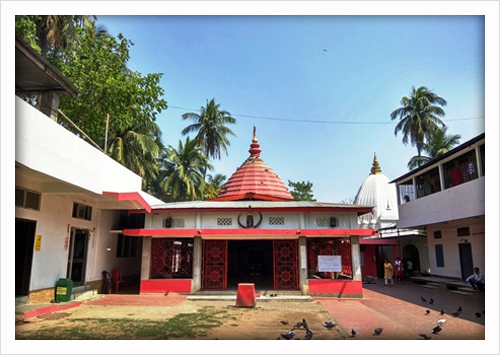
Ugro Tara Temple is an important Sakti shrine dedicated to Tara (Devi) located in the western side of Jur Pukhuri in the heart of Guwahati city in the Latasil. Legend has it that the navel of Sati, first consort of Shiva, is related to this temple.
The present temple of Ugra Tara was built by Ahom King Siva Singha in 1725 AD who had excavated a tank three years before known as Jur Pukhuri, which is situated to the east of the temple. The tank still exists, though the upper section of the temple was destroyed by a devastating earthquake. This was however rebuilt by a private citizen.
Kalika purana describes a Shakti peetha called Dikkaravasini. Dikkaravasini has two forms, Tikshna kantha and Lalitha kantha. Tikshna kantha is black and potbellied, also called as Ugra Tara or Ekajata. Lalitha kantha is gracefully attractive, also called as Tamreshwari.
In the garbhagriha of Ugra Tara there is no image or idol of her. A small pit filled with water is considered as the Goddess. There is a Shivalaya beside Ugra Tara temple and a pond behind both temples.
Maha Bhairav Temple
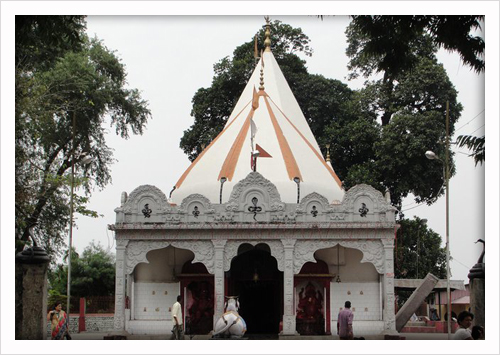
The Maha Bhairav Temple is devoted to Lord Shiva and is located at a hillock on the northern part of Tezpur in Assam. This temple is believed to have been established by king Bana in the pre-historical times. The temple was originally built of stone but the present one was renovated and built with concrete.
Maha Shivaratri is celebrated with enthusiasm as devotees come from far and wide. A special Laddu laced with Bhang, an edible preparation of cannabis and also mixed with milk and spices, are offered as prasad to Lord Shiva as per the rituals. Various pujas are also conducted at this temple, pigeons are also freed that symbolizes that spirit of ancestors are being liberated
Tamresveri Temple

The Tamresveri Temple is located in Sadiya in the northern Lakimpur district of Assam. The temple is in a dilapidated condition in the forests at a distance of 7 kilometres from the place. The style of construction of the temple is unique where the entire structure is a single stone building, constructed without cement. The stone has been held together by iron-pins but without any clamps. The interior of the temple has magnificent sculpted images of birds, animals, flowers, and superb geometrical designs.
Navagraha Temple

The Navagraha temple is located in Chitrachal hill in the south eastern part of Guwahati city in Assam. The temple is devoted to Navagraha—the nine (9) major celestial bodies (Grahas) of Hindu astronomy. These celestial bodies are named Surya (Sun), Chandra (Moon), Mangala (Mars), Budha (Mercury), Brihaspati (Jupiter), Shukra (Venus), Shani (Saturn), Rahu (North Lunar Node) and Ketu (South Lunar Node).
The temple is a research centre of both astrology and astronomy. The tower of the temple and a bigger part of it was earlier destroyed by an earthquake, but later it was resurrected. The temple which is in existence at present was built by the King Rajesvar Singha in 1752 A.D. The garbhagriha or the inner quarter of the temple survived the earthquake, while the upper portion was rebuilt with corrugated iron sheets.
Da Parbatia Temple

Da Parbatia Temple located in the village of Da Parbatia a few kilometres west of the city of Tezpur in Assam, is one of the oldest Hindu temples in Assam known for its finest representation of architectural splendour. Famous for sculptural or iconoclastic art in Assam in the form of the ruins of the door-frame of the Da Parbatia temple.
Archaeological excavations done here in 1924 have unearthed a sixth century antiquity in the form of a stone door frame with extensive carvings. The ruins of the temple built during the Ahom period are built over the ancient temple's foundations and are in the form of a stone paved layout plan of the sanctum sanctorum and a mandapa. This complex is under the jurisdiction of the Archaeological Survey of India and its importance and notability is recorded under the Ancient Monuments and Archaeological Sites and Remains Act 1958.
Sukreswar Temple
The Sukreswar Temple is an important Shiva temple in the state of Assam constructed in 1744 by Ahom King Pramatta Singha. King Rajeswar Singha who also promoted cause of the Saiva cult made financial provisions for the Sukreswar Temple in 1759. Leading down from the temple compound is a long flight of steps to the Brahmaputra river from where one can view the picturesque Umananda Island, the smallest river Island in the world, or enjoy the scenery of sun setting on the river, boats moving across the river, people performing puja in honour of their relatives who have left this world, children and older people bathing, far removed from the din and noise of the city.
The temple is located on the Sukreswar or Itakhuli hill on the south bank of river Brahmaputra in the Panbazar locality of Guwahati city.
Hayagriva Madhava Temple
Hayagriva Madhava Temple is located on a hill called Manikutain the town of Hajo, around 30 km to west of Guwahati, Assam. The temple enshrines an image of Lord Vishnu, which resembles the image of Lord Jagannath at Puri (Orissa). The temple is also considered as a major pilgrimage spot for the Hindus, Buddhist Lamas and Bhutiyas who follow Buddhism. It is believed that Lord Buddha acquired Nirvana or Moksha in this place.
The entrance to this shrine is made of four blocks of granite and is about 10 feet high and 5 feet in width. The exterior of the temple has huge sculptured figures, representing the 10 Avatars, with Buddha as the ninth.
There is a big pond known as Madhab Pukhuri near the temple where people offer food to the fish and turtles. Doul, Bihu and Janmastami festivals are celebrated every year in the temple.
Tilinga Mandir

The Tilinga Mandir is located in Bordubi, a small town which is 7 km far from Tinsukia District of Assam. This is a famous Temple dedicated to Lord Shiva in Upper Assam. Tilinga means ‘bell’ and mandir means ‘temple’ in Assamese and hence the temple is known as the “Temple of Bells” or “Tilinga Mandir”. This temple has the largest collection of bells and has made it to the Limca Book of World Records for hosting the largest collection of bells of all types in this temple. There are copper, bronze, brass and aluminium bells, in different sizes weighing anything between 50 grams to 55 kg.
In 1965, local residents of the area noticed a Shiva Lingam emerge from the ground near the banyan tree where the Tilinga Mandir temple is now situated. According to Hindu mythology, banyan trees are considered “Kalpavriksha”, or “wish fulfilling divine trees” and it is believed that if someone hangs a bell from the banyan tree at Tilinga Mandir their wish will come true. It is popularly believed that if your wish comes true, you are supposed to return to Tilinga Mandir and tie a bell.
Pilgrims visit the shrine throughout the year, with Monday being a particularly popular day.
Mahamaya Temple

The Mahamaya temple or the Mahamaya Dham of Bagribari is a sacred place of Hindu worship. This holy shrine is located in the Kokrajhar District of Assam. It is 30 kms. from the town of Dhubri and 10 kms. from the town of Bilasipara. It is very well connected by road and rail from Guwahati. It is on the National Highway 31 and there are a lot of buses and taxi services available from the city. This ancient Hindu temple is famous for its religious significance and has a rich cultural and historical heritage. It is one of the greatest Shakti Peethas and attracts a lot of pilgrims and tourists every year.
The Mahamaya temple is famous for its 400-year old tradition of animal sacrifice, especially during the time of Durga Puja. There is a magnificent idol of Goddess Kali and Lord Hanuman in the temple premises which is an extravagance for the tourists.
Another place of worship connected to Mahamaya goddess is the Mahamaya Snaanghat Temple, which is situated few kilometres away from the main Mahamaya temple. In the ancient time, as the local people belief, it is the place where the Goddess Mahamaya used to take bath. From that time, the place came to be known as Mahamaya Snaanghat. Every year in the month of January around, a Shakti Yagya is performed here by the temple priests.
About Assam

Assam is situated in the North-East of India and is the largest northeastern state in terms of population while second in terms of area. Assam covers an area of 78,438 km2 (30,285 sq miles). The state is bordered by Bhutan and the state of Arunachal Pradesh to the north; Nagaland, Arunachal Pradesh and Manipur to the east; Meghalaya, Tripura, Mizoram, and Bangladesh to the south; and West Bengal to the west. A significant geographical aspect of Assam is that it contains three of six physiographic divisions of India – The Northern Himalayas (Eastern Hills), The Northern Plains (Brahmaputra plain), and Deccan Plateau (Karbi Anglong).
Page Statistics
- Total Views: 640779
- Content Last viewed on: 03-Dec-2024
- Last updated on: 09-Dec-2020

